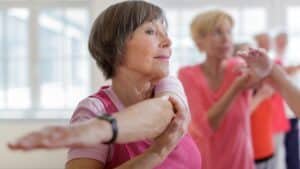
I believe we all know the importance of getting regular cardiorespiratory exercise and resistance (weight) training throughout our lifespan. That doing so will help reduce our risk for cardiovascular disease, hormonal based cancers, certain musculoskeletal conditions, and provide for a life with more vigor – the ability to go and do.
And certainly, there are the “other” associated psychological and emotional benefits. Simply stated, the human body was meant to be worked for it to perform properly.
However, I am often asked if older folks (60 and over) really need to stretch. They will ask, “Do I need to stretch all my major muscle groups, or how should I go about stretching now that I am older?”
The Principles of Stretching
To properly address the reasons for stretching throughout the entire lifespan, we need to understand some important related stretching principles.
Static Stretching
There are different types of stretching used for different purposes. Static stretching, where you move into the stretch position slowly and hold the position for 10 to 30 seconds, is used for the purpose of lengthening the muscle over time (called elongation) for increased flexibility and joint range of motion.
Dynamic Stretching
Dynamic stretching, where you move your limbs back and forth rhythmically through the range of motion is more appropriate for the purpose of preparing the body muscles for increased activity. In other words, this type of stretching is appropriate for pre-game warm up to enhance athletic performance and reduce the risk for injury.
However, dynamic stretching can also be used as a good “warm up” for static stretching because the movement of the limbs generates heat as a byproduct of muscle contraction, warming the muscles, making them more pliable and ready to be elongated.
What to Stretch
You need not stretch all major muscle groups, only those that, if they lose flexibility, place you at risk for certain pathological musculoskeletal conditions or are associated with increased pain.
Four Important Reasons Why We Really Should Stretch in Our Later Years
To Maintain Mobility
The primary reason why we lose our flexibility and therefore our mobility is due to a reduction in our movement as we grow older. Older folks fatigue quicker as our ability to generate ATP (the energy currency of the body) diminishes as we age.
This all too often leads to less movement and activity, and we significantly reduce the movement of our limbs through a good range of motion. It is not due to some physiological changes in our muscles simply due to the aging process.
Greater mobility allows us to engage in a wider variety of activities. To a great extent, the things we have enjoyed doing all our lives should still be available to us as we maintain our mobility.
To Reduce Joint and Muscle/Fascial Pain
Our joints are moved by the muscles that cross over and act upon them. These muscles cross the joints on all sides and there must be a proper balance in strength between the muscles on opposite sides of the joint. This is referred to as the agonist–antagonist muscle strength ratio.
When this proper ratio exists, the muscles work together to keep the joint stable and to maintain the normal properly balanced pressures that exist on the articulating surfaces of the bones that form the joint.
If this ratio is lost, then abnormal pressures are placed on certain parts of the joint surfaces (cartilage) and this produces pain. It can also cause or accelerate the cartilage breakdown contributing to the development or exacerbation of arthritis.
Further, the fascia that surrounds muscles or are part of a joint’s soft tissue structure, become shortened. Consequently, if a person with this condition does move through a greater range of motion than that which they have become accustomed, this stretches the fascia and causes pain. And, of course, the pain causes most folks to avoid that movement, and the cycle continues.
Reduce the Risk of Associated Musculoskeletal Issues
Let’s look at some of the more common musculoskeletal issues and their potential problems that people may develop because of losing flexibility in select muscle groups.
A Kyphotic Posture with Associated Rounded Shoulders and a Forward Head
This poor posture position increases the risk of developing shoulder rotator cuff impingement and tendinitis issues, both of which are painful and may dramatically affect use. Tight muscles: pectorals, scapular elevators, suboccipital muscle group.
A Lordotic Posture with Anterior Pelvic Tilt and Increased Low Back Curvature
This poor posture position increases the risk of developing low back pain. Tight muscles: hip flexors, low back extensors.
Tight Hamstring Muscles
Because these muscles if tight, reduce the amount of hip flexion that can occur, and if a person is bending a lot at the hip, then more than is normal range of motion must occur at the low back instead at the hip and can compromise normal movement.
Tight Calves
When we sleep, our ankles naturally move into a plantarflexed position, or the foot drops downward. This increases the likelihood that the calf muscles become tight, and this is one of the major causes of why a person may develop plantar fasciitis.
To Reduce the Risk of Falls
If our joints become restricted in their ability to move freely through a normal or good range of motion, then our ability to react to an event that produces a loss of balance could be impaired, and a fall might be the consequence. To us in the 60+ age category, we are especially at risk for fracture to our femur bone (hip fracture) and the consequences of this traumatic injury.
A Few Concluding Comments Specific to Stretching
- Always perform a general warm-up prior to stretching, especially of the muscles you plan to stretch. Contracting those muscles as part of the warm-up (see information on dynamic stretching in the early part of this article) will produce heat and better prepare them to be stretched.
- Stretch a muscle or muscle group only to the point of discomfort, not pain.
- Hold each new stretch position (gradually moving further through the range of motion with each succeeding set) for between 10 and 30 seconds.
- Try to stretch at least two non-consecutive days per week, with three or more days of stretching helping you arrive at your range of motion goal sooner.
Let’s Have a Conversation:
Are you experiencing pain at some joints or are you experiencing discomfort associated with postural deviations from normal? Have you planned stretching for increased range of motion into your goals for 2023? If you are experiencing joint pain, give stretching a shot and see if the pain is reduced or if it goes away.





